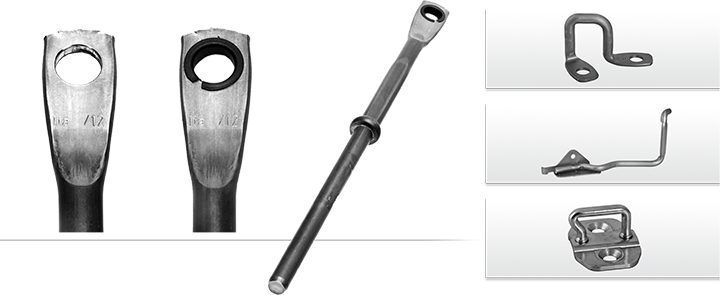| Stage I | Stage II | Stage III+IV |


| Stage V | Stage VI |
Wire diameter 12 mm, flattening with 1600kN, marking, conveying, jointing and calibrating of the bushing, finished part falling out at 18 pcs./min., power requirement approx. 20 kW, different gauging methods incl. data logging possible
Flattening and Jointing
Almost all metal parts require more than one process during their fabrication. This is especially true when referring to parts that will be assembled with others which usually require very specific characteristics to be able to work together as a whole.
Flattening and jointing usually belong to the manufacturing process of the parts described before when they are fabricated from metal wire.
What is flattening?
As the name suggests, it is the process of taking something with a round profile, like a metal wire, and making it flat. This can be done manually by hammering the wire, but a better result is usually achieved by means of a press in a cold forming process.
The application of this process is to allow for a change of profile in a given section of the part, moving from a round profile to a flat one.
What is jointing?
Here, the name is suggesting the presence of a joint. This is the process where two or more parts are assembled into a whole, and there are different ways to achieve it, including welding, screws and nuts or any other fastener, and so on. However, we want to highlight the jointing process where a round section is assembled into a hole, allowing movement by means of a bush.
From the description above, it is clear that the main application is providing a secure joint between different parts and allow relative movement between those parts.
Each of these processes require special tooling and expert operators to achieve the desired results. Moreover, there are certain considerations that must be taken, such as the precision required to determine the length of the flat section that is created, and the precision required to calibrate the bush into the corresponding hole.
Flattening and jointing with Schmale machines
To avoid human error in the activities described before while increasing efficiency and productivity for your business, Schmale machines provide automated solutions that integrate flattening and jointing with other required processes such as marking, bending and conveying into the same production cycle. Moreover, Schmale Machinery provides high precision bushing calibration to achieve high level performance.
The processes can be performed on metal wire with diameters of up to 25 mm (1”), and the whole cycle on the shown sample part will only take 3 seconds along 7 stages to get the part ready to market. The resulting capacity will be 18 pieces per minute and this will result in an increase of profitability thanks to the shorter time to market. For a better view of the process you can refer to the pictures.
If you are looking for an automated flattening and jointing solution, or you have any further questions, please do not hesitate to contact us and we will gladly help you.
